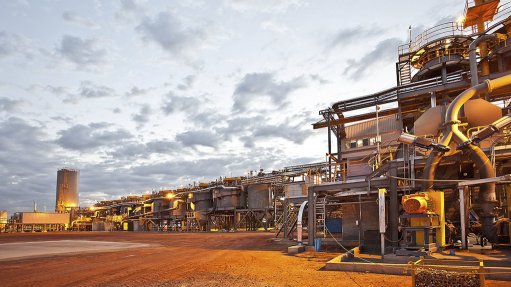
POWER RANGER The concentrator at the DeGrussa mine provides 20% of the mine’s energy requirements
One of the largest solar-battery-diesel hybrid systems globally – Sandfire Resources’ DeGrussa hybrid project, in Western Australia – has achieved its yearly generation targets one month ahead of schedule.
The project, at copper miner Sandfire’s DeGrussa copper mine, is wind and solar energy provider juwi Australia’s most notable project, confirming that juwi’s hybrid systems can reliably power off-grid sites while reducing diesel consumption and carbon dioxide emissions.
The hybrid project saves the mine about five-million litres of diesel yearly. Further, in relation to the yearly power demand of the mine, the hybrid project contributes about 20% of the mine’s total energy consumption.
The project consists of a 10.6 MW tracking photovoltaic project and a 6 MW battery, coupled with a hybrid control system that juwi developed, constructed and has been operating and maintaining since 2016.
“The increased generation achieved is attributed to juwi’s ability to understand the complete hybrid project, through being involved in the project as the developer, engineering, procurement and construction, as well as operations and maintenance, provider,” notes juwi hybrid global head Dave Manning.
He adds that the control system optimisations were a result of constructive collaboration between all the stakeholders comprising juwi, Sandfire, renewable-energy company Neoen, multinational corporation ABB and power generation service provider KPS.
The collaboration on DeGrussa proves that the technical and commercial challenges associated with utility-scale renewable energy in the mining sector can be overcome, says Manning.
He notes that the hybrid control system, which manages the integration of solar and battery with an existing diesel power station on the project, was developed in Australia using ABB hardware and software.
It took about six months to develop the customised software, which was further refined and optimised over a two-year period after commercial operation “… to maximise the amount of renewable energy that could be consumed by the DeGrussa mine,” says Manning.
Meanwhile, juwi South Africa is constructing solar projects comprising about 250 MW and is also developing a number of wind projects in South Africa.
The company has also signed several preliminary agreements with mining companies in South Africa to supply lower-cost renewable energy, paired with battery storage, to ensure better energy availability.
Manning concludes that, with juwi’s knowledge and experience gained from DeGrussa and the soon-to-be-completed hybrid system at the Agnew gold mine – also in Western Australia and operated by gold miner Gold Fields – juwi is keen to work with other mining companies to deliver low-cost and more reliable energy power systems.